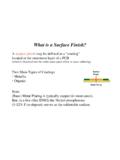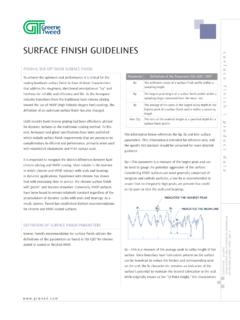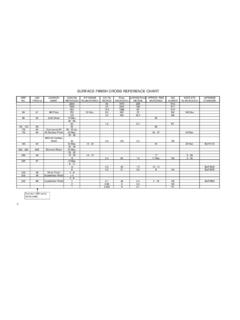Transcription of Aerospace Engineering Guide
1 Aerospace Engineering Guide21 Latest information available at April 2008 Surface finish (Measurement Methods)Ra- Arithmetic Average RoughnessRoughness averages are the most commonly usedparameters because they provide a simple value foraccept/reject decisions. Arithmetic average roughness , orRa, is the arithmetic average height ofroughness-component irregularities (peak heights andvalleys) from the mean line, measured within the samplinglength, L. See figure measurements are taken as the fine point of the styluson a profilometer which traverses the sampling length onthe surface being = individual measured peak heightLValleyPeakMean lineRa=1 LqL0|y(x)|dxRq=1 LqL0Yz(x)dx nX Figure 29 Surface finish - RaVersus RqRq- Geometric Average RoughnessRqis the current term for what was formerly calledroot-mean-square or RMS.
2 Rqis more sensitive to occasionalhighs and lows, making it a valuable complement to the geometric average height of roughness -componentirregularities from the mean line measured within thesampling length, L. Compare to Rain Table high or low readings, while Rasimply averagesthem. For a given surface, therefore, the Rq value will behigher than the Ra value (by approximately 11%). That is,a surface finish that measures V Surface finish Conversion TableRa,AA,CLARqor RMSG erman-English(min.)Metric(mm)English(min .)German-SwissNorm1) :Arithmeric average roughnessAA: Arithmeric averageCLA:CenterLineAverageRq:Geometric average roughnessRMS: Root-mean-square1)The German-Swiss Norm is a series of roughness -gradenumbers used to avoid confusion with numerical values ofother Measurement MethodsThe Rameasurement does not give a true picture of the realsurface profile.
3 The finish process plays a very importantrole in the outcome. In particular, the open profile PeakStructure can seriously affect seal performance, as itsjagged structure can cut and nick the seal surface. On theother hand the closed profile form valley structure , givesimproved seal performance, because the valleys retain fluidand lubricate the running seal surface. Please see Table VI RaComparisonSurface with identical Ravalues, the resulting sealperformance will be very Engineering Guide22 Latest information available at April 2008 Animprovedsurfacemeasurementmethodisdesc ribedinthenewISO13565-1/ -2/ -3,includingthepeak,valleyandmaterialrat ios as described lineMaterial ratio Mr%Figure 30 Abbot CurveRk(Core roughness )The core roughness depth is the depth of the roughnesscore (Material Ratio)
4 Mr1in %The material portion Mr1is determined by the intersectingline which separates the protruding peaks from theroughness core %The material portion Mr2is determined by the intersectingline which separates the valleys from the roughness (Reduced peak height)The reduced peak height Rpkis the average height of theprotruding peaks above the roughness core (Reduced valley depth)The reduced valley depth Rvkis the average depth of theprofile valleys projecting through the roughness harder the material the more important it is to reducethepeakheightRpk. If mating surface is ceramic, the because the hard peakswill cut into the seal areskewnesssandkurtosis,whichgive a more detailed picture of the surface.
5 For skewPositive skewLeptokurtic(>3)Platykurtic(<3)Figure 31 Surface Measurement Visualiz






